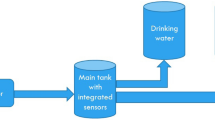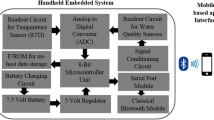Abstract
Heavy metal contamination in drinking water and water resources is one of the problems generated by increasing water demand and growing industrialization. Heavy metals can be toxic to humans and other living beings when their intake surpasses a certain threshold. Generally, heavy metal contamination analysis of water resources requires qualified experts with specialized equipment. In this paper, we introduce a method for citizen-based water-quality monitoring through simple pattern classification of water crystallization using a smartphone and portable microscope. This work is a first step toward the development of a Water Expert System smartphone application that will provide the ability to analyze water resource contamination remotely by sending images to the database and receiving an automatic analysis of the sample via machine learning software. In this study, we show the ability of the method to detect Fe 2 mg/1 L, 5 mg/L,10 mg/L polluted distilled water compared with other heavy metals (Al, Pb) pollution. The experimental results show that the classification used method has an accuracy greater than 90%.
This project was partially supported by BAUBAP 2019.01.05.
Access this chapter
Tax calculation will be finalised at checkout
Purchases are for personal use only
Similar content being viewed by others
References
Adverse health effects of heavy metals in children. World Health Organization (2011)
Brewer, M., Scott, T. (eds.): Concise Encyclopedia of Biochemistry. Walter de Gruyter, Berlin, New York (1983)
Poyraz, B.: Farklı Lokasyonlardan Alınan İçme Sularında Ağır Metal Analizi [The heavy metal analysis of drinking waters sampled from different locations]. University of Düzce, Bilim ve Teknoloji Dergisi, no. 2 (2014)
Zhong, X., **e, H., Duan, F.: Deposition patterns from evaporating sessile droplets with suspended mixtures of multi-sized and multi-species hydrophilic and non-adsorbing nanoparticles. Appl. Therm. Eng. 111, 1565–1572 (2017)
Domingos, P.: A few useful things to know about machine learning. Commun ACM. 55(10), 78–87 (2012). https://doi.org/10.1145/2347736.2347755
Chicco, D.: Ten quick tips for machine learning in computational biology. BioData Min. 10(35), 8 (2017). https://doi.org/10.1186/s13040-017-0155-3
Ying, X.: An overview of overfitting and its solutions. J. Phys. Conf. Ser. 1168, 022022 (2019)
Hinton, G., Srivastava, N., Krizhevsky, A., Sutskever, I., Salakhutdinov, R.: Improving neural networks by preventing co-adaptation of feature detectors. ar**v preprint ar**v:1207.0580 (2012)
Simonyan, K., Zisserman, A.: Very deep convolutional networks for large-scale image recognition. ar**v preprint ar**v:1409.1556 (2014)
Ronneberger, O., Fischer, P., Brox, T.: U-net: convolutional networks for biomedical image segmentation. ar**v:1505.04597 (2015)
Simon, P., Vijayasundaram, U.: Deep learning-based feature extraction for texture classification. Proc. Comput. Sci. 171, 1680–1687 (2020). https://doi.org/10.1016/j.procs.2020.04.180
Razavian, A.S., et al.: CNN features off-the-shelf: an astounding baseline for recognition. In: 2014 IEEE Conference on Computer Vision and Pattern Recognition Workshops, pp. 512–519 (2014)
Petrovska, B., Zdravevski, E., Lameski, P., Corizzo, R., Štajduhar, I., Lerga, J.: Deep learning for feature extraction in remote sensing: a case-study of aerial scene classification. Sensors 20, 3906 (2020). https://doi.org/10.3390/s20143906
https://scikit-learn.org/stable/modules/classes.html#module-sklearn.ensemble. Accessed 29 Oct 2021
Author information
Authors and Affiliations
Corresponding author
Editor information
Editors and Affiliations
Rights and permissions
Copyright information
© 2022 Springer Nature Switzerland AG
About this paper
Cite this paper
Rada, L., Tanrıverdi, Y.B., Kara, Ö.E., Hemond, E.M., Tezel, U. (2022). Toward Automatic Water Pollution Analysis: A Machine Learning Approach for Water-Quality Monitoring Through Pattern Classification of Water Crystallization. In: Brito-Loeza, C., Martin-Gonzalez, A., Castañeda-Zeman, V., Safi, A. (eds) Intelligent Computing Systems. ISICS 2022. Communications in Computer and Information Science, vol 1569. Springer, Cham. https://doi.org/10.1007/978-3-030-98457-1_9
Download citation
DOI: https://doi.org/10.1007/978-3-030-98457-1_9
Published:
Publisher Name: Springer, Cham
Print ISBN: 978-3-030-98456-4
Online ISBN: 978-3-030-98457-1
eBook Packages: Computer ScienceComputer Science (R0)




